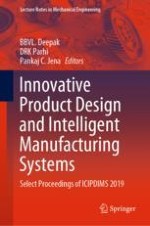2020 | OriginalPaper | Buchkapitel
Generation of Slip Line Fields Incorporating BUE and Shear Zone to Model Machining Using MATLAB
verfasst von : Hridayjit Kalita, Kaushik Kumar
Erschienen in: Innovative Product Design and Intelligent Manufacturing Systems
Verlag: Springer Singapore
Aktivieren Sie unsere intelligente Suche, um passende Fachinhalte oder Patente zu finden.
Wählen Sie Textabschnitte aus um mit Künstlicher Intelligenz passenden Patente zu finden. powered by
Markieren Sie Textabschnitte, um KI-gestützt weitere passende Inhalte zu finden. powered by
